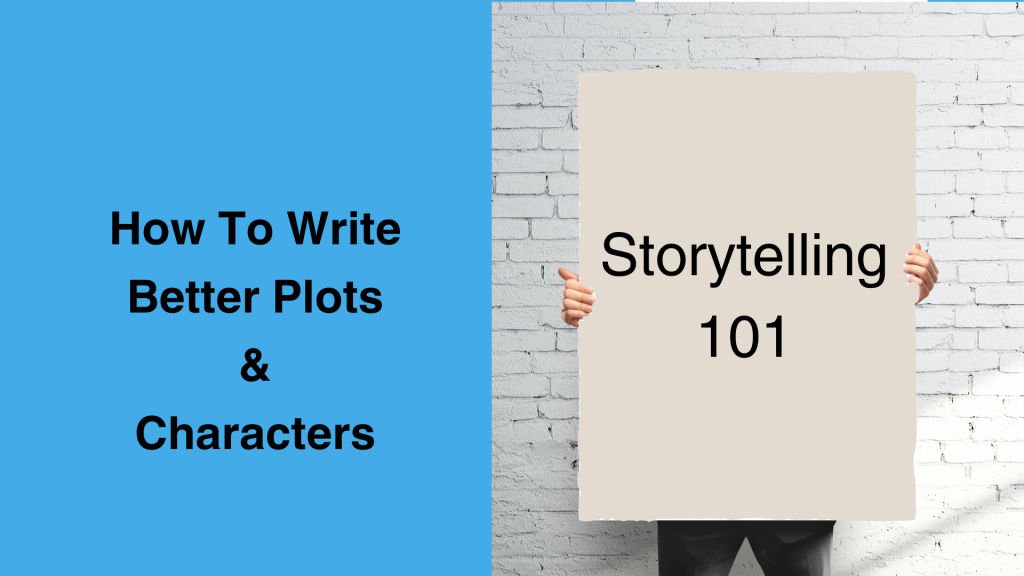Write Better Characters And Plots – 5 Tips

It feels like there are a million and one things that go into writing a good story and just as many things to get wrong. This is true for novels, screenplays, TV shows, video games, and anything with a story. In truth, good storytelling comes down to two main things – Good characters and a good plot. So, today, I’ll cover everything you need to know to write better characters and plots and have better stories.
To write better plots and stories we’ll learn to:
- Establish both character want and need for better characters
- Turn basic ideas into cohesive story plots
- Write more relatable but engaging narratives
- Understand plot structue and how it impacts character delelopment
- Stay true to your voice as a writer
While it’s only five tips, they’re some of the most importnat things you should be doing as a writer to help level up your plots and characters. We’ll break down each one below in detail and give examples when possible. There’s a lot to cover that you won’t want to miss, so let’s jump right in.
How To Write Better Characters And Plots
Our characters and plotlines aren’t nearly as separate as they seem. In fact, they’re intrinsically intertwined and feed and grow off of one another. Understanding a few simple concepts about motivation will paint a clear idea of what I mean. Beyond that, we’ll cover tips for turning your basic ideas into solid plots. So, without further ado, let’s get started.
Establish Want Vs. Needs
When people talk about writing good characters and plots, they often reference the importance of character motivation. Indeed, it is essential to both a quality character and the plot of our stories; most people realize this. However, it’s even more important to establish our character’s wants vs. their needs. Let me elaborate.
You May Also Like: How To Write Unique Characters With LivingWriter
A “want” is what we generally refer to as character motivation and is what a character wants to achieve throughout the story. This want also drives the plot of the story from start to finish. The “need” is the underlying factors that the character must address in order to grow and be fulfilled. The need defines the plot’s theme and drives the emotional aspects.
| Wants | Needs |
| The character’s external goal or desire | The character’s internal growth or emotional journey |
| What they actively pursue throughout the story | What the character requires on a deeper, often subconscious level |
| Drives the conflict of the plot | Drives character arc, complexity, development, and sub-plots |
| Typically tangible, observable, or physical goals | Usually, internal circumstances rooted in the character’s psyche, fears, desires, or flaws |
| Creates external conflict, drives the plot forward, and engages the reader’s interest | Ultimately leads to their emotional catharsis or growth, providing a sense of resolution and closure to their character arc |
As an example, let’s look at The Great Gatsby. What does Gatsby want? Gatsby wants to win back Daisy Buchanan and relive their past romance. What does Gatsby need to be truly happy? To come to terms with the illusion of the American Dream, let go of his obsession with the past, and find meaning beyond material wealth.

For another example, let’s use Harry Potter. Harry wants to defeat Voldemort and bring peace to the wizarding world. But Harry needs to deal with his past, accept the importance of love and friendship, and ultimately sacrifice himself for the greater good.
You need both a want and a need to have good characters and a good plot. When done well, need and want are complementary elements that contribute to forming memorable, complex, and compelling narratives that resonate with readers and leave a lasting impression.
The Importance Of Both Want And Need
You should now have a clear idea of character wants vs needs and their purpose. However, I want to briefly touch on the importance of having both instead of one or the other. For these examples, let’s look at some famous films.
Note: This isn’t to say these films are bad, just that they’re one-dimensional
A Want Without A Need
For a want without a need, you could reference Die Hard. John McClane’s want is to save his wife. And while he faces physical obstacles that present conflict, he lacks a need. There’s really no character development or evolution throughout the plot. Instead, he’s a man on a mission, driven only by the want to save his wife. This isn’t an emotionally investing or heavily thematic story.
A Need Without A Want
On the other hand, take The Wizard of Oz. It’s all need; No want. Dorothy learns the importance of home and family, as well as discovers her own strength and courage. Her journey through the Land of Oz and encounters with various characters help her realize these qualities.

However, she has very little proactive motivation in the story, aside from her vague goal of returning to Kansas. This is a clear example of being all about the journey without emphasis on the destination. Dorothy is a different character at the end than at the beginning, but there is no real conflict and resolution to drive an exciting plot.
Turning Ideas Into Plots
Have you ever gotten a great idea for a story, started to write and then realize that a great idea is not enough to have a successful story? This happens because an idea is not a story. Many more components tie into the need and want concept from above.
So, let’s dive into how you can turn your general ideas into meaningful plots. We’ll start with a few basic questions you can ask yourself to ensure you have all the basic info you need. Ask yourself these questions when you get an idea for a story:
- Who is it about?
- What do they want?
- Why can’t they get it?
- What do they do about that?
- Why doesn’t that work?
- How does it end?
If we can ask (and answer) these six questions about our idea, we can successfully turn it into a plot. Before you try it, it may seem a bit too clear-cut, but I promise it works for everything from novels to TV shows. Let’s apply these questions to a hypothetical idea – An unsolved case from his past haunts a retired detective.
- Who is it about?
- The protagonist is Detective John Michaels, a retired investigator grappling with the ghosts of his past.
- What does he want?
- John wants closure for an unsolved case that has haunted him for years, hoping to find answers and put his demons to rest.
- Why can’t he get it?
- Despite his best efforts during his active career, John could not crack the case, and now, years later, the trail has gone cold, with no new leads or evidence to pursue.
- What does he do about that?
- Despite the odds, John becomes obsessed with reopening the case, diving back into old files, revisiting crime scenes, and reaching out to former colleagues and witnesses in search of any overlooked clues.
- Why doesn’t that work?
- Despite his determination, John’s investigation only serves to reopen old wounds and dredge up painful memories, leading to strained relationships with his loved ones and frustration as he hits dead end after end.
- How does it end?
- The story concludes bittersweetly, as John accepts that some mysteries may never be solved. However, through his journey, he finds a sense of closure and acceptance, allowing him to move forward with his life and find peace amid uncertainty.
In this example, the resolution may not offer a clear-cut solution to the protagonist’s central goal, but it provides emotional closure and growth, which ties directly into a clear need/want dynamic like we covered above.
Using these six simple questions you can be certain that even your most basic ideas to be turned into a great story. If you have trouble coming up with an answer for one of these, you probably don’t have a fleshed-out enough idea for your work yet.
If that’s the case, don’t be afraid to “shelf” it for a while and come back later. In my experience, these little breaks from less-than-complete ideas often spark up the missing piece when you’d least expect it.
You May Also Like: How To Get Ideas For Writing – 6 Must-Know Tips
Relatable But Fantastic Plots
Sometimes a story seems to do everything right; The characters motivations are there, the story has a clear opening, middle and end, and the writing is well done… And still, it seems to be missing that “x-factor” that prevents a reader from dropping the book. Unfortunately, this happens all the time. But why?
In my experience, when a well-planned, well-written story falls flat, it’s missing something that the reader relates to or something extraordinary. The two may seem counterintuitive, but they go hand-in-hand.
You want something that readers can relate to and see within themselves. But if you leave it at that, there’s no incentive to read further. A novel about financial struggle, someone who gets up and goes to work everyday to survive, is very relatable to many, but isn’t something many would read all by itself.

On the other hand, if you make your story all larger-than-life events, for example, a superhero story, you risk lacking any tangible, relatable human qualities or struggles and fail to engage readers on a deeper emotional level.
Let’s take the novel Fight Club by Chuck Palahniuk.
The protagonist leads a monotonous life as a disillusioned office worker, struggling with insomnia, consumerism, and a lack of purpose or identity. He seeks meaning and escape from the soul-crushing conformity of modern society.
While I would hope people are better off than the books narrarator, those are things readers could relate to and see within themselves. Maybe they don’t like their job, feel they lack an overall purpose, or fall into the trap of consumerism – Whatever it may be, the character known only as “narrarator” is very human.

And while we can look at him and say, “I’ve felt that, I know what that’s like, or I can see myself in this character,” we’ve (probably) never suffered a psychological breakdown and started an underground fight club, where men escape societal norms, embrace physical violence, and reclaim their primal instincts.
Parts of the character are things many people experience daily. However, it wouldn’t be entertaining if it were only a story about the mundane side of things that we relate to without the lapse into a clandestine anti-establishment movement and a dark and surreal journey of self-discovery and rebellion.
Crafting Compelling Characters through Plot Structure
Alright, let’s dive into the nitty-gritty of plot structure and how it influences our beloved characters. Think of plot structure as the skeleton of your story—it gives your narrative shape and form, guiding your characters through their journey from beginning to end.
For this point, I’m going to use a simple three-act structure.
Understanding the Three-Act Structure
Act 1 sets the stage, introducing our characters and their world while establishing the central conflict. Act 2 is where the action heats up, throwing obstacles and challenges in our characters’ paths as they strive toward their goals. Finally, Act 3 brings everything to a satisfying conclusion, resolving conflicts and tying up loose ends.
You May Also Like: How LivingWriter’s AI Outlines Work
Having a structure in mind as you write helps you control the flow and pace of your story and ensure that everything is cohesive. It also allows you to view your characters through the lens of story progression and be sure they grow and progress along with your plot.
Character Evolution Across Acts
Now, here’s where it gets interesting. As your characters embark on their journey, they should evolve and grow organically in response to the events unfolding around them. A character in Act 1 may be naive, hesitant, or even resistant to change. But as the story progresses into Act 2, they’ll face trials and tribulations that force them to confront their flaws and adapt to their circumstances.
Act 1 vs. Act 3 Character Behavior
Let’s break it down further. In Act 1, our protagonist might shy away from conflict, preferring to avoid confrontation and maintain the status quo. However, by Act 3, they’ve undergone significant growth and transformation, facing their fears head-on and taking decisive action to overcome obstacles.
For example, imagine a timid office worker who discovers a hidden talent for leadership during a company crisis. In Act 1, they might hesitate to speak up in meetings or challenge authority. But by Act 3, they’re rallying their colleagues, making tough decisions, and leading the charge toward a brighter future.
It’s also important to allow your characters to evolve. It’s easy to sit down with the idea of “my story is about a a timid office worker; That’s the character.” and let that initial idea stop us from writing the Act 3 character that no longer has those traits.
Crafting Cohesive Character Arcs
The key here is to ensure that your characters’ actions and decisions are consistent with their evolving personalities and motivations. Each plot point should deepen their arc, revealing new layers of complexity and depth as the story unfolds.
So, as you map out your plot structure, keep a close eye on how your characters change and grow along the way. By having character arcs that align with the beats of your story, you’ll create a narrative that resonates with readers and keeps them eagerly turning the pages.
Staying True to Your Voice
Your voice or style is your literary fingerprint—a unique expression of your personality and perspective. Embrace your quirks, idiosyncrasies, and personal style. Authenticity resonates deeply with readers and helps build yet another layer in your work for readers to attach to.
That said, it’s one of the hardest things to pin down and put your finger on, especially as a new writer. But trust me, you do have your own voice. The words you choose, how you write them, your subject matter, characters, everything about how you write is somewhat unique to you.
Here are a few tips to stay true to your style or voice as a writer.
Trust Your Instincts
Again, if you’re a new writer, you may think you lack this. However, I promise you don’t; You do have an instincual way to write. Listen to your inner voice as you write. Trust your instincts to guide you toward authentic expression. If something feels right, write it. If it doesn’t, perhaps change it.
Even if you wrote something you felt was completeley out of the norm for you, someone who knows you and is familiar with your writing would undoudably still pick up on your voice within, even if you didn’t even realise it was there to begin with.
Write How You Speak
Imagine conversing with a close friend as you write. Strive for a natural conversational tone that mirrors a true spoken voice within the given circumstances. Doing this builds immediacy, and realism helping to invest readers in your world and goes a long way in ctaching unnatural dialogue.
If you’re writing something like pirates or aliens with a very different way of speaking, my advice is to keep the flare to a minimum and still add those relatable elements throughout. Unique dialect and ways of speach in moderation is great but when overdone or lacking a familar element readers could feel as if they need a translator for the book.
Refine And Evolve
While staying true to yourself, don’t be afraid to experiment or allow your voice to evolve. Try new techniques, explore diverse perspectives, and push the boundaries of your comfort zone. Growth lies in the willingness to adapt and refine your craft.
As mentioned, your authentic voice is a lot harder to shake than you’d think. So, feel free to take inspiration from others, take risks, do different things, write anything and everything that comes to mind; Just allow yourself to do it as you.